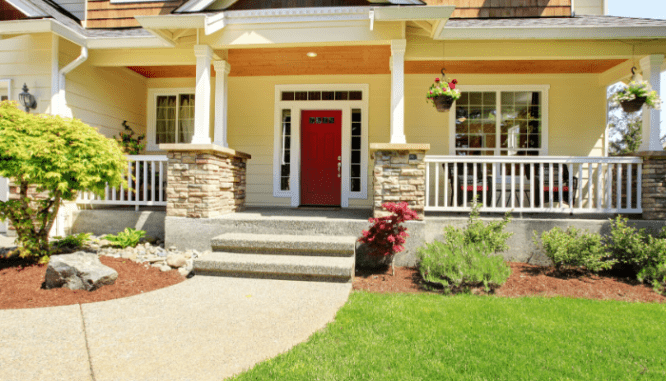Exactly How Much Value Does Sprucing Up Your Curb Appeal Add?
- Published on
- 3 min read
-
 Dena Landon Contributing AuthorClose
Dena Landon Contributing AuthorClose Dena Landon Contributing Author
Dena Landon Contributing AuthorDena Landon is a writer with over 10 years of experience and has had bylines appear in The Washington Post, Salon, Good Housekeeping and more. A homeowner and real estate investor herself, Dena's bought and sold four homes, worked in property management for other investors, and has written over 200 articles on real estate.
When you hear the term “curb appeal,” you probably see a specific home in your mind’s eye — but have you ever stopped to ask yourself how much that white picket fence cost to install, or what that homeowner spends on fresh annual flowers every year?
New homebuyers typically walk through the front door with a list of projects they want to do to make it “theirs.” If you added items related to curb appeal to your list, it’s fair to ask yourself: how much value does curb appeal add? We all want to get value for our money, and a home is your biggest investment. So let’s dig into it.

Why curb appeal matters
The term “curb appeal” refers to the first impression that people get of your home. When they pull their car up in front, what do they see? Well-kept flower beds, a neatly cut lawn, and fresh paint? Or weeds, overgrown grass, and chipping paint?
Agent Howard Watts, who works as part of a team in Michigan, thinks that “First impressions are critical. It’s why we spend a lot of time with our seller clients making sure that they do the most they can to create a positive first impression.”
Many homebuyers view curb appeal as an indication of how meticulous you are keeping up other parts of your house. They reason that if you take pride of ownership on the exterior, that carries through to the home’s interior. Watt’s partner, Glenda Gerbstadt, says that great curb appeal can help sellers beat out a similar home on the market, or even command a premium.
Why buy a house that lacks curb appeal?
When you were home shopping, your agent might have pointed out a neighbor’s property if your home lacked curb appeal. It’s what Watts does to help his buyers envision a place spruced up.
“Providing you don’t mind spending the time and money to improve curb appeal, you can get a really good deal on the neighborhood’s ugly duckling,” he points out. If the house lacked curb appeal when you bought it, it probably turned away other potential buyers.
Now is time to figure out how much value curb appeal adds so you can make more when you do sell.

What goes into curb appeal
What falls under the umbrella term, “curb appeal?” Things that relate to the home’s structure and overall appearance.
The house itself
Take a walk around your home’s exterior. Do you see broken windows or shutters, or holes in the screens? Replacing them one at a time is more cost-effective than tackling them all at once. Window replacement starts at $200 per window and replacing and installing a new screen ranges from $133 to $457.
Touch up chipped or peeling paint, and pressure-wash stucco or siding to keep it looking fresh. You can rent a pressure washer from a local hardware store and do it yourself in just one afternoon, or pay a professional $0.08 to $0.35 per square foot.
Are your gutters sagging or detaching from the fascia? Gutter repairs and screen replacements can be less than $200 but have a big payoff when it comes time to sell. Fixing these issues protects your home’s foundation from water damage, conserves heat, and increases your curb appeal.
Along with cleaning out gutters, fix any loose shingles on the roof. A house’s roof protects everything beneath it, and buyers worry about signs of deterioration. Replacing a roof can cost $4,000 or more, depending on your roof’s size, age, and the number of gables and eaves. While it’s an expensive fix, many buyers avoid homes that require a lot of work.
In Gerbstadt’s opinion, “well-maintained is the biggest aspect of subjective curb appeal.” If your home’s exterior doesn’t imply that you’ve kept up on maintenance, she says that any prospective buyers already have an opinion about the property and will be asking themselves what else you didn’t maintain.
Landscaping
Once springtime rolls around, you can do more outside. A beautiful front lawn, with fresh-cut grass and colorful flowers, entices people to stop and linger. Watts likes nice, clean beds, and advises perennials if you want something that won’t be a lot of work. HomeLight’s research indicates that a well-landscaped exterior can boost a home’s value between 1% and 5%.
Keep up with the mowing and weeding, or consider an eco-conscious choice like a wildflower or rock garden in place of grass. Refresh mulch around flowers, trees, and bushes, and keep them trimmed and nicely shaped. HomeLight’s Q2 Top Agent Insights Report backs this up: over 84% of agents agree that sellers should install fresh mulch and over 85% recommend trimming trees and shrubs before selling.
Older, mature trees and shrubs give you the most value. Shrubs alleviate the need to purchase annuals to fill in gaps in flower beds. Taller trees can block unsightly views — like the broken trampoline in your neighbor’s backyard.
Book an arborist as part of your annual home maintenance plan to keep your trees healthy. Arborists know which branches to trim back or remove to encourage healthy growth, and they can recommend a spray program to control insects. Aerating roots ensures that they receive enough oxygen. Mature trees cost thousands of dollars, but some gardeners estimate that they add thousands of dollars to your home’s value.
If your ultimate goal is to list the house for sale, too much landscaping can turn off buyers, so avoid complex, high-maintenance designs. Buyers might worry about the time and money involved in upkeep. As well, landscaping styles that don’t fit the home or neighborhood — like a rock garden in New England or formal designs around a Cape Cod — will detract from its overall appeal.
It’s much easier and cheaper to improve curb appeal slowly over time rather than all at once. The average homebuyer stays in their home for 13 years before selling, so make your list of improvements and strategize.
Lighting
Adding exterior lighting brightens and warms your home’s appearance. Hard-wired lights in landscaped beds, pointing upwards, can highlight beautiful windows or landscaping even if a homebuyer visits at night.
Choose bulbs that are bright enough for outside, or consider adding solar lights along pathways. Lighting improves both appearance and safety, preventing someone from tripping over an uneven walkway. An agent won’t have to fumble for a key in the dark when bringing by potential buyers.
Can you add it up?
It’s tough to say exactly how much value curb appeal can add to a house; a lot depends on the home’s state when you moved in. If the outside of your new home already looked nice, you probably don’t have much to do and will see a minimal value boost from improvements. But if you bought the ugly duckling, turning it into a swan could massively bump up your home’s value.
Even if you can’t quantify how much value curb appeal adds in numbers, top agents say it’s a worthwhile investment. Many homeowners find that they enjoy outdoor maintenance projects and gardening, especially when the weather’s nice. And, you’ll get to enjoy living in a prettier home in the meantime.
Header Image Source: (Curtis Adams / Pexels)
